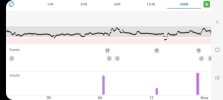JellyBaby21
Active Member
- Relationship to Diabetes
- Type 1
Okay, so I'm REALLY confused and wondering if there is anyone on here that can help me. Here's my situation...
I was, until recently, using the Libre 2 without too much issue. However, I have recently started a medical trial which requires me to use the Dexcom G6. Brilliant I thought, access to a proper CGM. The Dexcom G6s are provided through the trial and not on the NHS. So I am now 4 weeks into using the Dexcom G6 and am on my 3rd sensor. I'm pretty happy with it, although the Dexcom app is not quite a good a the Libre (lacks the notes option and for detailed info you have to go onto Clarity instead of accessing on the same app. But overall it's good.
The trial requires all participants to wear the Dexcom G6 on the stomach. Fine.
We have to use the transmitter (provided) but can run the Dexcom G6 app on our phones alongside this. Fine.
But, here's where I'm confused. The trial company have said that I am calibrating the Dexcom G6 too much. The nurses and cotors overseeing the trial are confused and do not know why this would be a problem. I only calibrate the Dexcom G6 when it says that I am low and I am in fact nowhere near. For example, it has just said I was 3.9mmol/L and my finger prick said I was 6.8mmol/L. So I calibrated. This kind of discrepancy happens quite for what it claims are lows. I've started using the 20% rule (but I have read this only applies in the US??) I have also noticed that if the margin is big (like this example) then the dexcom will only change it's reading to a point when I calibrate - so in this instance it would only read 6.1mmol/L and not the 6.8mmol/L I actually was. I have found that if I enter the calibration twice then it forced the Dexcom G6 to read the finger prick number (but this obviously looks like even more calibrations to the trail company!) Most of the time to reading on the Dexcom G6 is very accurate. I know if my bloods are changing fast it cannot keep up etc and that you should really only calibrate if your bloods are trending stable. I start the sensor using the code so it has never officially asked me to calibrate.
So my question is, what am I officially meant to do in these situation when the difference between the Dexcom G6 and the finger prick is well outside of the 20% range? I can't really see that the sensor is faulty as it is accurate most of the time. Should I be calibrating at all? Should I be calibrating? Should I calibrate every time the reading is over 20% out? Why would they be concerned I am calibrating too much?
Any advise on this would be greatly appreciated- I'm so confused!
I was, until recently, using the Libre 2 without too much issue. However, I have recently started a medical trial which requires me to use the Dexcom G6. Brilliant I thought, access to a proper CGM. The Dexcom G6s are provided through the trial and not on the NHS. So I am now 4 weeks into using the Dexcom G6 and am on my 3rd sensor. I'm pretty happy with it, although the Dexcom app is not quite a good a the Libre (lacks the notes option and for detailed info you have to go onto Clarity instead of accessing on the same app. But overall it's good.
The trial requires all participants to wear the Dexcom G6 on the stomach. Fine.
We have to use the transmitter (provided) but can run the Dexcom G6 app on our phones alongside this. Fine.
But, here's where I'm confused. The trial company have said that I am calibrating the Dexcom G6 too much. The nurses and cotors overseeing the trial are confused and do not know why this would be a problem. I only calibrate the Dexcom G6 when it says that I am low and I am in fact nowhere near. For example, it has just said I was 3.9mmol/L and my finger prick said I was 6.8mmol/L. So I calibrated. This kind of discrepancy happens quite for what it claims are lows. I've started using the 20% rule (but I have read this only applies in the US??) I have also noticed that if the margin is big (like this example) then the dexcom will only change it's reading to a point when I calibrate - so in this instance it would only read 6.1mmol/L and not the 6.8mmol/L I actually was. I have found that if I enter the calibration twice then it forced the Dexcom G6 to read the finger prick number (but this obviously looks like even more calibrations to the trail company!) Most of the time to reading on the Dexcom G6 is very accurate. I know if my bloods are changing fast it cannot keep up etc and that you should really only calibrate if your bloods are trending stable. I start the sensor using the code so it has never officially asked me to calibrate.
So my question is, what am I officially meant to do in these situation when the difference between the Dexcom G6 and the finger prick is well outside of the 20% range? I can't really see that the sensor is faulty as it is accurate most of the time. Should I be calibrating at all? Should I be calibrating? Should I calibrate every time the reading is over 20% out? Why would they be concerned I am calibrating too much?
Any advise on this would be greatly appreciated- I'm so confused!

